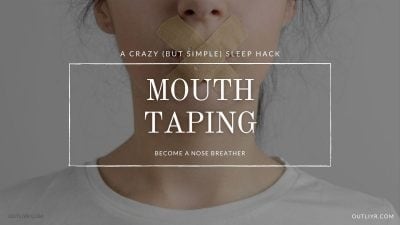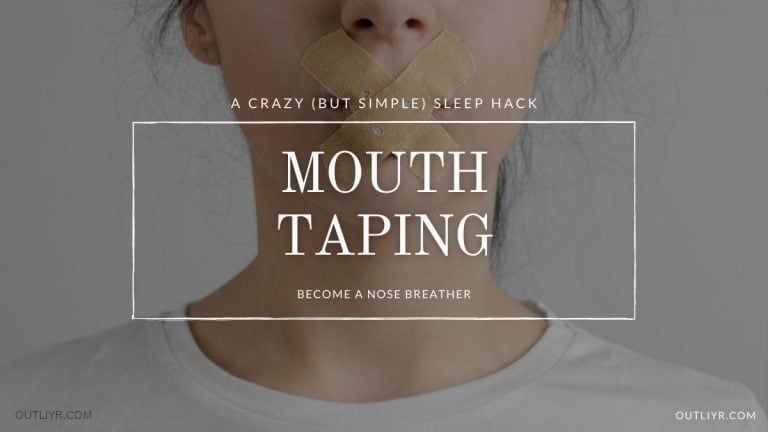“I know what you’re thinking. You won’t suffocate and die.”
My concerns exactly. Somehow, I still didn’t feel at rest. Not the gentlest preface to a new habit. But the idea stuck. Fast forward two weeks of intense research later, and I began taping my mouth closed every night before bed. My sleep has improved and I’ve quit the bad habit of mouth breathing.
Around the clock, I’m now enjoying 38+ health benefits unique to nose breathers. Other new mouth tapers report similar results:
“With nose breathing, I wake up feeling 10x more rested and even if I feel tired during the day, I hardly ever yawn anymore. Plus I have noticed my ability to process air during aerobic activity to improve 100 fold! I just ran a 5k the other day entirely with nose breathing only and finished in the top 5 of over 50”
One mouth taper reporting the benefits of becoming a nose breather.
In this guide I’ll teach you how to sleep with your mouth taped closed and the why mouth taping is a great sleep hack.
What is Mouth Taping?

Mouth taping is the process of deliberately blocking airflow through your mouth to force yourself to breathe through the nose. Nasal breathing is restorative and health promoting, while mouth breathing eventually leads to degeneration and disease.
The entire point of mouth taping is to train yourself to nose breathe. Certain positions, like sleeping on your back, open the mouth and cause unintentional mouth breathing.
How do you know if you’re a mouth breather or nose breather?
As I wrote in my article called Three Steps to Breathe Properly, mouth breathers often experience the following symptoms:
- Dry mouth
- Exhaustion
- Abnormal facial growth in children
- Bad breath
- Need more sleep
- Memory issues
- High blood pressure
- Worsened asthma
- ADHD symptoms
I, Nick Urban, mouth breathed for 23 years. Nose breathing exercises helped break the habit, but I reverted to unconscious mouth breathing during sleep. Then I began mouth taping.
Why I Mouth Tape Every Night
Gradually, I warmed up to the idea. One success story after the next. I investigated deeper only once certain health-uninterested friends asked my take.
According to Dental Sleep Practice, the benefits of taping the mouth for sleep include:
- Deeper, more restorative sleep
- Your breath pattern influences physical stress. Done right, a slow, deep breath really relaxes you. But there’s a caveat. Only breaths through the nose. Mouth breathing increases heart rate and the stress hormones adrenaline and cortisol. You wouldn’t sip a cup of coffee throughout the late night. Yet mouth breathing causes similar internal biochemical changes. All critical repairs occur during sleep. Mouth breathing prevents you from reaching the deepest, most restorative sleep stages.
- Less anxiety and stress
- Related to the above, your adrenal glands work harder to protect you against the (non-existent) perceived threat. Adrenals secrete more adrenaline, leading to the common symptoms of anxiety and stress. Nose breathing keeps stress naturally low.
- Healthy mouth
- Mouth breathing slowly destroys the mouth and oral health. Your oral microbiome changes killing beneficial bacteria and feeding bad bacteria. The mouth becomes more hospitable to plaque, gingivitis, bad breath, cavities, sensitive teeth, and negative facial structural changes. Over time mouth breathing skews the symmetry of your face.
- Nitric oxide release
- Dubbed a “miracle molecule“, nitric oxide improves strength, endurance, blood pressure, sleep quality, sexual functions, and memory, and reduces inflammation. You can get nitric oxide from food and supplements, or through nose breathing. Mouth breathers forego the extra nitric oxide protection.
- Self-perpetuating cycle
- Mouth breathers are for life. Each breath through the mouth makes nose breathing more difficult. Two (of the 38+) jobs of the nose are to filter and cool the incoming air. The mouth doesn’t filter or cool air at all. So the body produces mucus in defense. This congests the nose further and makes mouth breathing the only option.
Like any habit, the longer you mouth breathe, the harder to break the habit. Hope isn’t lost. But the process pays off big time. You can overcome mouth breathing. You’ll look, feel, perform, and even smell better from becoming a nose breather.
My favorite way to enforce the habit?
Mouth taping. Consult your doctor, gather the supplies, and get started.
The Necessary Supplies
Mouth taping is easy and convenient. You need just one product. A product that I keep in my overnight bag. And you might already have it:
Surgical micropore tape.
When choosing a mouth taping product, look for:
- Length: at least 2″
- Hypoallergenic
- Material breathability
- Comfortable
- Non-toxic adhesive
I use 3M mouth tape. It’s a form of surgical micropore tape unspecific to mouth taping. 3M tape is the cheap DIY option. That said, it’s quite narrow, porous, and sometimes leaves an adhesive residue.
The second, high-quality option is called Somnifix mouth tape. Somnifix is like 3M but designed specifically for mouth taping. Dentists recommend it. Users like that Somnifix includes a vent, so you can mouth breathe if absolutely necessary. Somnifix is also more comfortable, uses a better adhesive, and is hypoallergenic.
I recommend starting with 3M tape, and moving to the Somnifix if you like mouth taping or cannot stand 3M.
How to Mouth Tape Properly
Mouth taping is straightforward and only requires the right tape. Here are the steps to mouth tape properly and safely.
Total Time: 1 minute
Get good tape
3M and Somnifix make the most common mouth tape.
Cut the right amount amount
A strip 1-2 inches wide and 2-3 inch long is perfect.
Optional: Lubricate skin around mouth
Applying coconut oil, olive oil, vaseline or another product around the mouth can prevent skin irritation.
Position mouth comfortably
Once you tape your mouth closed, your lips become set in place.
Lightly apply tape, and lightly press around the tape to seat
Gently applying tape allows you to get comfortable before it sets.
Speaking from experience, beards complicate mouth taping. I cut any excess tape off before it touches my face. Be extra generous applying anti-stick product wherever tape may contact beard.
If all of this is too daunting, try mouth taping during the day. That way you can remove the tape whenever necessary.
Typical Mouth Taping Questions Answered
Is mouth taping safe?
Done properly, mouth taping is safe and effective. It should not be used in the following situations: after alcohol or sedatives, those with heart or breathing problems, cold or sinus infections, or if you have abnormally low blood pressure.
What tape do you use for mouth taping?
Surgical micropore tape is the best for mouth taping. The two best brands are the multipurpose 3M tape, and the premium, dentist-recommended Somnifix mouth tape. While both work, Somnifix is designed specifically for mouth taping.
How do you use mouth tape?
Mouth tape is applied around the mouth to prevent mouth breathing. Most people either use specific mouth tape (like Somnifix), or cut a 2-3 inch strip of 3M surgical micropore tape. The tape stays affixed until morning.
Does taping your mouth shut stop snoring?
An open mouth is a leading cause of snoring. Mouth taping is one common and useful way to stop snoring. Unlike other options like expanding or taping the nose, mouth taping effectively forces nose breathing.
Can a mouth breather become a nose breather?
A mouth breather can become a nose breather with practice. Each breath through the mouth reinforces mouth breathing, so taping the mouth shut at night works well to reverse the bad habit. It can take several weeks to months to become a nose breather.
Mouth Taping: My Radical Nightly Sleep Habit
Disclaimer: This is no substitute for medical advice. Please consult your health care provider before beginning any new practice.
I encountered mouth taping with skepticism. I worried that my nose would surely clog randomly throughout the night. And I’d suffocate. Or at very least wake up in a panic. I’m still alive and have only woken up when I break the rules and mouth tape with a stuffy nose.
Overcoming a lifetime of habitual mouth breathing isn’t an overnight process. Before taping, I unintentionally reverted to mouth breathing every night. For a full eight hours.
Now, my sleep scores have improved (read my other Oura Ring tips & tricks article). I wake up feeling more energized and ready to take on the day.
Not comfortable with the radical idea of taping your mouth shut during sleep? Try it during the day. Only once it becomes comfortable, add it to your bedtime routine.
If you’re looking for an athletic edge, to sleep better, sing without losing your voice, or just become healthier, look into mouth taping.
Suggested Teachings on Breathing:
- Book: The Oxygen Advantage by Patrick McKeown
- Book: Breathe by James Nestor
- Article: End Mouth Breathing for Better Sleep and a Healthier Mouth
- Article: The Wim Hof Method
- Article: Box Breathing
- Article: Alternate Nostril Breathing





